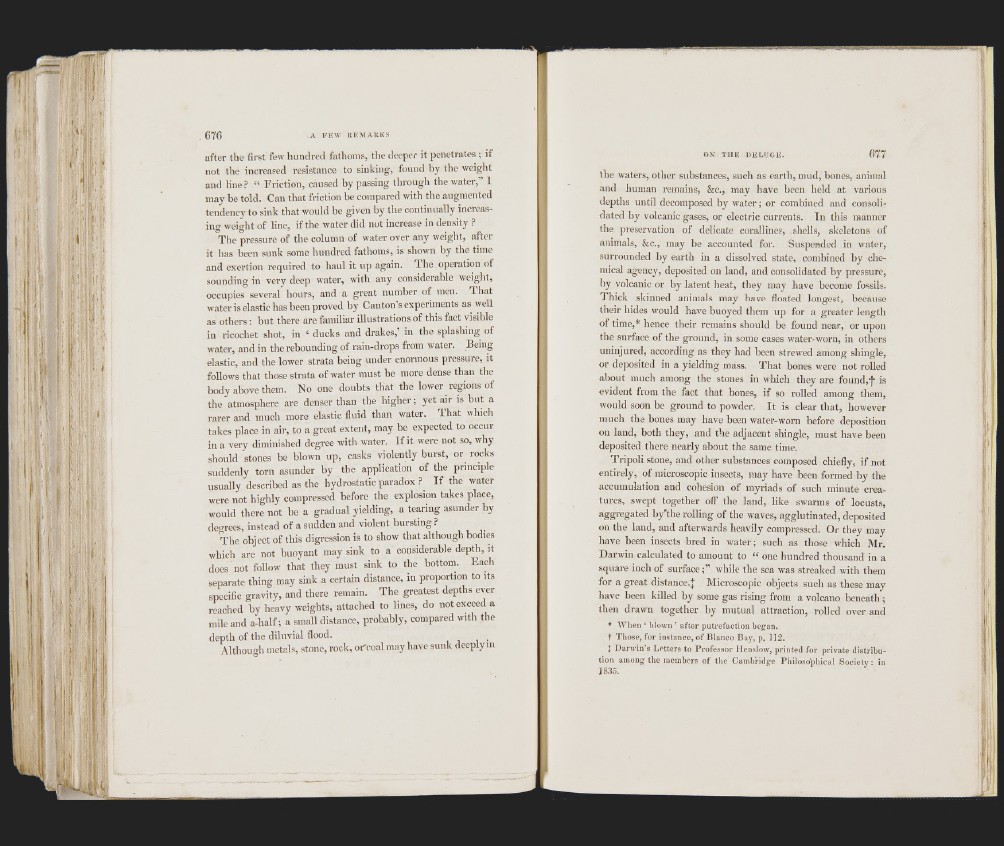
! 1 n • S . . 1.'
1
I
'
after the first few hundred fathoms, the deeper it peneti-ates; if
not the increased resistance to sinking, found by the weiglit
and line ? “ Friction, caused by passing through the water,” 1
may be told. Can that friction be compared with the augmented
tendency to sink that would be given by tbe continually increasing
weight of line, if the water did not increase in density ?
The "pressure of the column of water over any weight, after
it has been sunk some hundred fathoms, is shown by tbe time
and exertion required to haul it up again. The operation of
sounding in very deep water, with any considerable weight,
occupies several hours, and a great number of men. Ihat
water is elastic has heen proved by Canton’s experiments as well
as others; hut there are familiar illustrations of this fact visible
in ricochet shot, in ‘ ducks and drakes,’ in the splashing of
water, and in the rebounding of rain-drops from water. Being
elastic, and the lower strata being under enormous pressure, it
follows that those strata of water must he more dense than the
hody above them. No one doubts that the lower regions of
the atmosphere are denser than the higher; yet air is hut a
rarer and much more elastic fluid than water. That which
takes place in air, to a great extent, may be expected to occur
in a very diminished degree with water. If it were not so, why
should stones be blown up, casks violently burst, or^ rocks
suddenly torn asunder by the application of the principle
usually described as the hydrostatic paradox .? I f the water
were not highly compressed before the explosion takes place,
would there not be a gradual yielding, a tearing asunder by
degrees, instead of a sudden and violent bursting ?
The object of this digression is to show that although bodies
which are not buoyant may sink to a considerable depth, it
does not follow tlftt they must sink to the bottom. Each
separate thing may sink a certain distance, in proportion to its
specific gravity, and there remain. The greatest depths ever
reached hy heavy weights, attached to lines, do not exceed a
mile and a-half; a small distance, probably, compared with the
depth of the diluvial flood.
Although metals, stone, rock, or-coal may have sunk deeply m
; I'.'i
« < 1 It
î 'ï
1 ,
. I
!
I : .
r *1 d
1
the waters, other substances, such as earth, mud, hones, animal
and human remains, &c., may have been held at various
depths until decomposed hy water; or combined and consolidated
by volcanic gases, or electric currents. In this manner
the preservation of delicate corallines, shells, skeletons of
animals, &c., may be accounted for. Suspended in water,
surrounded by earth in a dissolved state, combined hy chemical
agency, deposited on land, and consolidated by pressure,
hy volcanic or by latent heat, they may have hecome fossils.
Thick skinned animals may have floated longest, because
tlieir hides would have buoyed them up for a greater length
of time,* hence their remains should be found near, or upon
the surface of the ground, in some cases water-worn, in others
uninjured, according as they had been strewed among shingle,
or deposited in a yielding mass. That bones were not rolled
about much among the stones in which they are found,# is
evident from the fact that bones, if so rolled among them,
would soon be ground to powder. It is clear that, however
much the bones may have been water-worn before deposition
on land, both they, and the adjacent shingle, must have been
deposited there nearly ahout the same time.
Tripoli stone, and other substances composed chiefly, if not
entirely, of microscopic insects, may have been formed by the
accumulation and cohesion of myriads of such minute creatures,
swept together off the land, like swarms of locusts,
aggregated hy’the rolling of the waves, agglutinated, deposited
on the land, and afterwards heavily compressed. Or they may
have been insects bred in water; such as those which Mr.
Darwin calculated to amount to “ one hundred thousand in a
square inch of sur facewhi le the sea was streaked with them
for a great distance.] Microscopic objects such as these may
have heen killed hy some gas rising from a volcano beneath ;
then drawn together hy mutual attraction, rolled over and
* When ‘ blown ’ after putrefaction began.
t Those, for instance, of Blanco Bay, p. 112.
I Darwin’s Letters to Professor Henslow, printed for private distribution
among the members of the Cambridge Philosophical Society ; in
1835.
it.